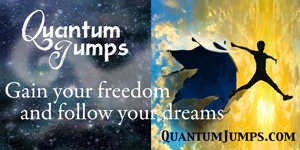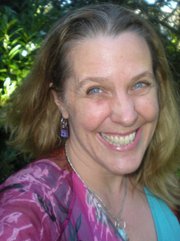 Is there a connection between how and what we pay attention to–and quantum jumping? And if so, how does it work?
Is there a connection between how and what we pay attention to–and quantum jumping? And if so, how does it work?
While preparing to be interviewed by Brian MacFarland this month, I was pleased that he was particularly intrigued by something He’d heard me say, regarding the way that Mandela Effects and reality shifts tend to occur “in the peripheries of our minds.” Brian asked me to please elaborate on what I meant by that. Perhaps one of the easiest ways to grasp this concept is through some thing known as the shyness effect. In the simplest terms, we typically only see mind matter interaction outside of our direct line of sight. Most Reality Shifts, Quantum Jumps, and Mandela effect are witnessed after the edges of our attentional focus, out on the periphery.
Over the last 25 years that I’ve dedicated my professional life to tracking the reality shift phenomenon, one of the most striking aspects to me has been the way that there’s something akin to a “shyness effect” going on. In 1975, physicist John G. Taylor first began using this term to describe the interesting phenomenon by which demonstrations of mind-matter interaction are often more readily made unobtrusively, rather than under close scrutiny or observation. This “shyness effect” has provided skeptics with ammunition by which to ascribe the possibility of ‘cheating’ or practicing sleight-of-hand to spoon-bending mentalists such as Uri Geller.
While I can see why people might feel skeptical regarding Uri Geller’s spoon bending occurring just out of visual line of sight, I have witnessed my daughter ‘melt’ / bend a fork at a spoon-bending party in our home. And I’ve held a perfectly normal quarter in my hand and felt it melt like soft, malleable putty into a curved shape while I was relaxed and attempting to get it to stay firm and solid as I inserted it into a coin slot at our local underground public transportation station. I can personally testify to neither of those two cases being examples of sleight-of-hand, since there was no possibility of any illusionist practices in either of those instances.
And my first encounter with the shyness effect occurred when I was a young girl of about five years of age, looking out our living room window into the backyard, watching the rain. I noticed that the rain seemed to directly respond to my thoughts, such that when I thought, “Stop rain,” the rain would immediately stop. And when I thought, “Start rain,” the rain would start again. I did this back and forth several times, until I was certain that I was as one with the rain, and with great excitement, I ran to find my mom, to tell her what I’d observed. I noticed when I found her in her bedroom that she seemed interested at first to hear what I had to say, that is, until she heard me say, “Look, Mom! The rain stops when I think Stop rain, and starts when I say Start rain!” She crossed her arms (not the best sign), and try as I might, I could not get this demonstration to work.
When I first met Uri Geller in San Francisco in 1999, I was intrigued to witness something similar to him in one of his psi demonstrations. He’d asked a volunteer to “think of a color,” and at some point told us he was picking up interference–that clearly, not everyone was sending a clear image for him. One man standing in the back of the room admitted that yes, he had been telepathically sending a color of his own.
Your Mind is as good, if not better than, Quantum Computers
I mentioned in my book Quantum Jumps that we are starting to observe scientific evidence of macroscopic quantum phenomenon occurring in nature. It has long been assumed by many scientists that we would not be able to witness any type of quantum phenomenon within the warm, wet, noisy environment of natural biological systems. It came as quite a surprise then,to observe that photosynthesis in plants appears to definitely be happening thanks to quantum entanglement. it also seems likely that we will soon be able to witness other types of condom phenomena being employed in our own senses such as smell, thanks to quantum tunneling occurring and natural systems that include our noses. another example of natural systems employing quantum processes includes birds navigational systems, and we can expect to see many more examples in the years to come.
It is clearly not necessary for birds, plants, and our noses to be consciously operating quantum computers in order to benefit from microscopic quantum phenomena. and it is not necessary for many of us to employ quantum phenomena in our daily lives, when we feel that we are receiving direct intuitive insights from those who are not indirect contact with us at that time. We can certainly envision that thanks to quantum entanglement with others with whom we feel heartfelt connection and coherence, we have some kind of a quantum mechanism by which experiences like telepathy can be enjoyed.
We are also finding that our minds operate very much in a quantum manner, as described in the wonderful book, Quantum Models of Cognition and Decision. I interviewed Jerome Busemeyer in my Living the Quantum Dream podcast, talking about the amazing and wonderful quantum properties our minds demonstrate.
Walking between Worlds with the Quantum Zeno Effect (QZE)
Most of us are familiar with those situations where it seems that the more we stare at a given situation, waiting for a momentous phase change to occur, the less likely it seems we’ll see much of anything interesting transpire. You might have heard your someone say, “A watched pot never boils,” suggesting you find something more productive to do than stand and stare, waiting for water to get hot enough to come to a boil. Amazingly, the “watched pot” phenomenon is backed up by some pretty interesting scientific studies in quantum physics. With respect to quantum systems, the Quantum Zeno Effect (QZE) provides a mechanism by which a quantum system consisting of entangled particles can be locked in place, simply by consistently and persistently observing it in whichever state is most desired.
While Alan Turing has been acknowledged as having first mentioned the basic principle behind the Quantum Zeno Effect in the form of a paradox in 1954, physicists Baidyanaith Misra and George Sudarshan were the first to write a paper in 1977, hypothesizing that if a quantum system is measured often enough, it’s state will be unable to progress, and this hypothesis was tested and proven to be true in a 1989 experiment involving laser-cooled ions trapped in electric and magnetic fields. Subsequent tests further confirmed that the Quantum Zeno Effect works, and in 2013, researchers moved a step closer to building quantum computers by demonstrating that objects as large as diamonds can exhibit the Quantum Zeno Effect.
We might envision the possibilities of being able to freeze-frame a given situation–such as a life-threatening experience–in order that we can best address whatever needs to be handled. Some people, including me, have had such moments where we could have sworn that time slowed to a stop–and the Quantum Zeno Effect can go a long way toward explaining what’s going on when that happens. We also have opportunities to select realities that we most enjoy, on occasions when we witness some kind of flip-flop, back-and-forth between to possible alternative realities. Thanks to the Quantum Zeno Effect (QZE), we can persistently make observations of what we must wish to experience, thereby locking a particular entangled quantum system in place. In practical, down to earth terms, this simply means that when we are riding a bicycle or a motorcycle, we can either fix our eyes on the horizon toward our desired destination, or we can stare at the pothole coming up ahead of us in the middle of the road. We know from learning from experienced instructors to avoid staring at the pothole, unless we truly desire to hit that pothole. in similar fashion, we know that if we continue gazing at our desired destination, we can best avoid potholes and ensure a safe passage.
Putting all of this together, we can practice making desired Quantum Jumps in our lives by staying focused on desired outcomes when we are focusing our attention, and also by providing relaxed states of mind that wave-like and open to all possibilities, in order to provide an optimal environment for Quantum Jumps to adjacent realities. For a tip on keeping things at the periphery of your mind, it might help to practice remembering things.
Have you ever tried to remember something, like somebody’s name, so hard that you couldn’t recall it at all? Most of us have learned that if we want to remember something, it helps to stop trying so hard, and relax. When we relax and let go of trying so hard, those parts of our mind that are entangled with what we are seeking have a chance to make the connections we seek, and provide us with the answer we were looking for. This provides us with a sense of how we can move back and forth between ‘locking in’ a particular focus of attention and reality, and entering into a relaxed daydream ‘wavelike’ state of providing opportunity for a quantum jump to occur.
You can watch the companion video to this blog post on YouTube here:
REFERENCES:
Reich, Eugenie Samuel, “Quantum Paradox Seen in Diamond,” Nature, 20 August 2013
Patil, Yogesh Sharad, Srivatsan Chakram, and Mukund Vengalattore. “Quantum Control by Imaging: The Zeno effect in an ultracold lattice gas.” arXiv preprint arXiv:1411.2678 (2014).
Larson, Cynthia Sue. Reality Shifts: When Consciousness Changes the Physical World. RealityShifters, 2011.
You can watch the companion video to this blog here:
___________________________
 Cynthia Sue Larson is the best-selling author of six books, including Quantum Jumps. Cynthia has a degree in physics from UC Berkeley, an MBA degree, a Doctor of Divinity, and a second degree black belt in Kuk Sool Won. Cynthia is the founder of RealityShifters, and first President of the International Mandela Effect Conference. Cynthia hosts “Living the Quantum Dream” on the DreamVisions7 radio network, and has been featured in numerous shows including Gaia, the History Channel, Coast to Coast AM, One World with Deepak Chopra, and BBC. Cynthia reminds us to ask in every situation, “How good can it get?” Subscribe to her free monthly ezine at:
Cynthia Sue Larson is the best-selling author of six books, including Quantum Jumps. Cynthia has a degree in physics from UC Berkeley, an MBA degree, a Doctor of Divinity, and a second degree black belt in Kuk Sool Won. Cynthia is the founder of RealityShifters, and first President of the International Mandela Effect Conference. Cynthia hosts “Living the Quantum Dream” on the DreamVisions7 radio network, and has been featured in numerous shows including Gaia, the History Channel, Coast to Coast AM, One World with Deepak Chopra, and BBC. Cynthia reminds us to ask in every situation, “How good can it get?” Subscribe to her free monthly ezine at:
Comments on: "Quantum Jumping from the Periphery of our Minds" (2)
Thank you, Cynthia, and Happy 2023. How good can it get? 💖
Awesome my dear sweet friend Beautiful article and loved when you share as a child For know it’s not easy sharing yours or your daughters gifts Thank you so much Wishing you all a wonderful weekend 🙂💗🌸🥰🥰💜